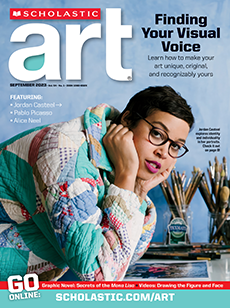The art movement known as expressionism flourished in the early 1900's. Expressionist artists turned away from representing scenes and objects realistically. Instead, the artists tried to reveal their inner feelings through their art. The subjects they chose to paint were often unsettling. Some subjects were frightening or even grotesque. Painting techniques, too, were designed to arouse an emotional response in the viewer. The artists often used distorted shapes, vivid colors, and twisting or swirling lines to show strong emotion.
Much art throughout history has had expressionist qualities. This is especially true of primitive and folk art. It is also true of medieval religious art of Germany and other areas of northern Europe. Even some romantic art of the early 1800's had these qualities. However, modern expressionism did not begin until the 1880's. The Dutch artist Vincent van Gogh was among the first to state expressionist goals. He said that he deliberately exaggerated nature to "express... man's terrible passions." The Starry Night (1889) and other works express Van Gogh's emotional suffering and inner turmoil. These works feature agitated brush strokes and looming shapes At about the same time, other artists used similar techniques to create works of great emotional intensity. Notable among them were the Belgian James Ensor and the Norwegian Edvard Munch.
About 1905 the first modern expressionist groups began to form. In France, one such group was led by Henri Matisse. These artists used bright, intense colors and bold but flat shapes in a way that was expressive rather than realistic. Their highly untraditional approach led critics to call them les fauves ("the wild beasts"). Their style became known as fauvism. In Germany, Ernst Ludwig Kirchner and other artists formed a similar group. It was called Die Brücke ("The Bridge").
A second group of German expressionists, Der Blaue Reiter ("The Blue Rider"), was organized in 1911. It included Franz Marc and the Russian artist Wassily Kandinsky. Gradually, some of the Blaue Reiter artists moved away from painting recognizable images. They painted colors and shapes that suggested feelings and moods but did not represent any real object. This kind of painting is called abstract expressionism. Other notable expressionist artists were Georges Rouault of France, Paul Klee of Switzerland, Oskar Kokoschka of Austria, and Max Beckmann and Emile Nolde of Germany.
The expressionist movement also extended to literature and music. The plays of the Swedish dramatist August Strindberg are considered part of the movement. So are the fiction of the German-Czech writer Franz Kafka and the music of the Austrian composer Alban Berg. These works are all characterized by disturbing subject matter, intensity of emotion, and the expression of inner states of mind.
Expressionism faded as a unified movement after World War II. But its goals and techniques continued to have a strong influence on modern art. In the United States and much of Europe, abstract expressionism, in particular, became one of the most important art movements of the later 20th century.
